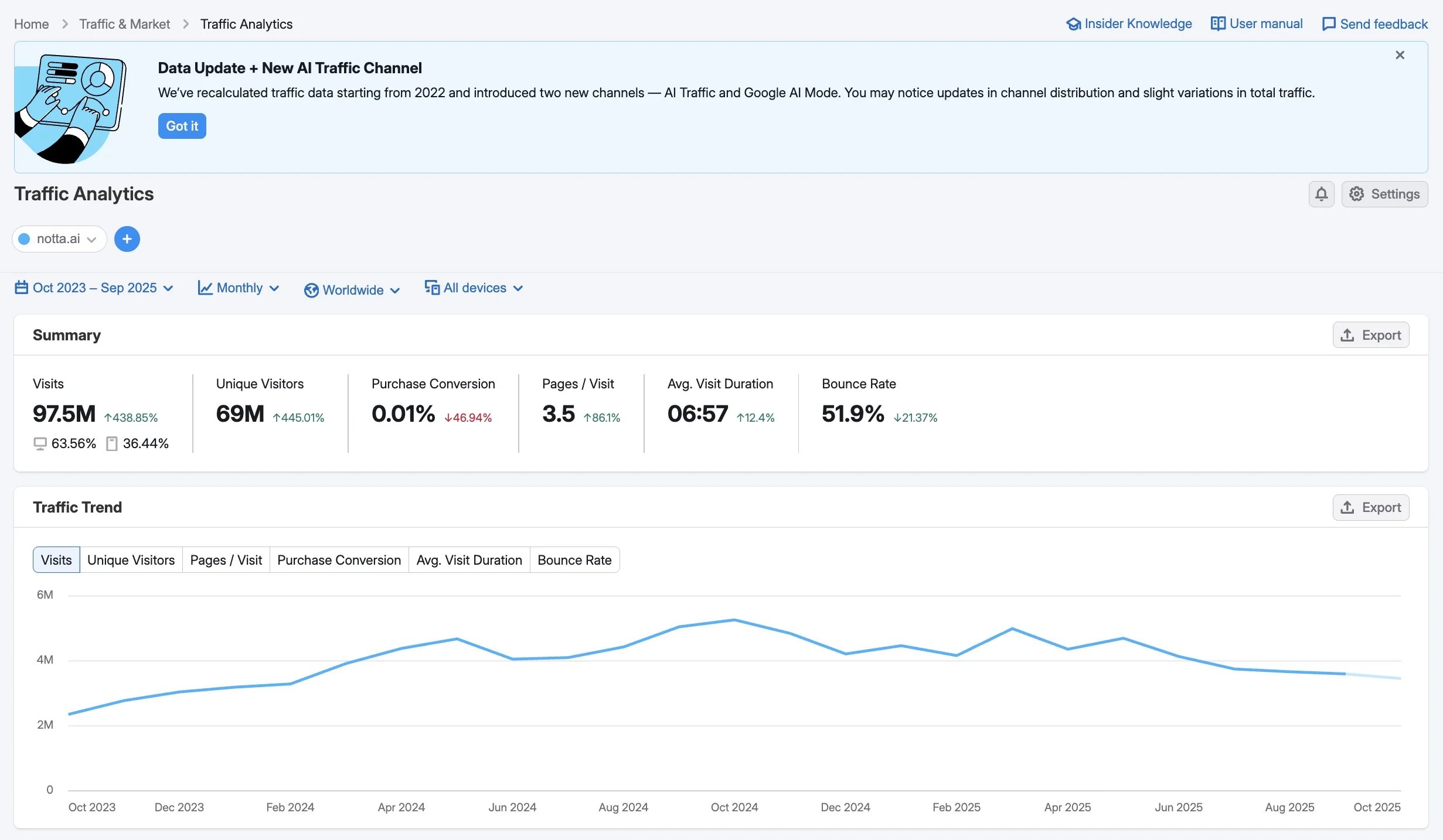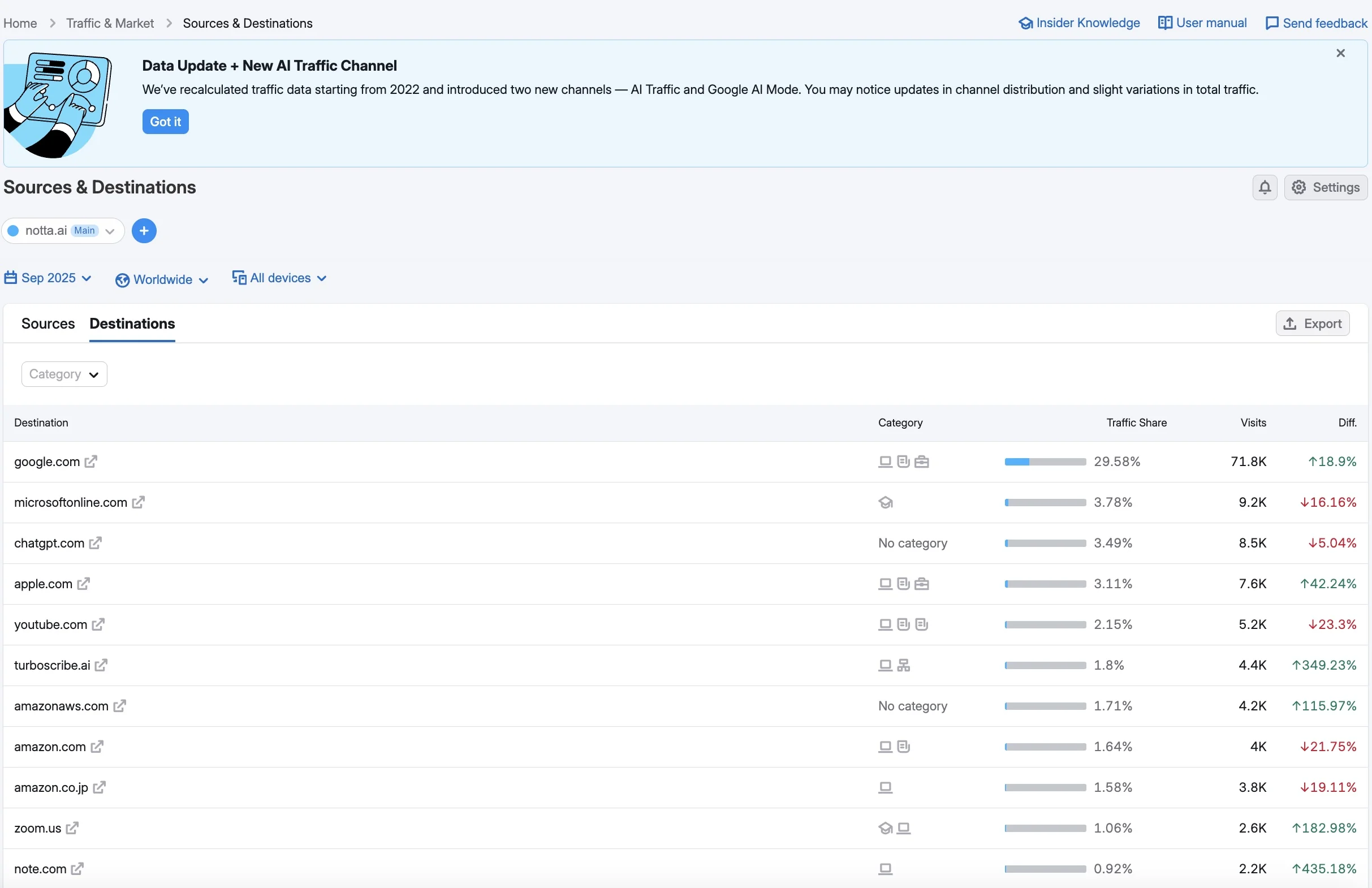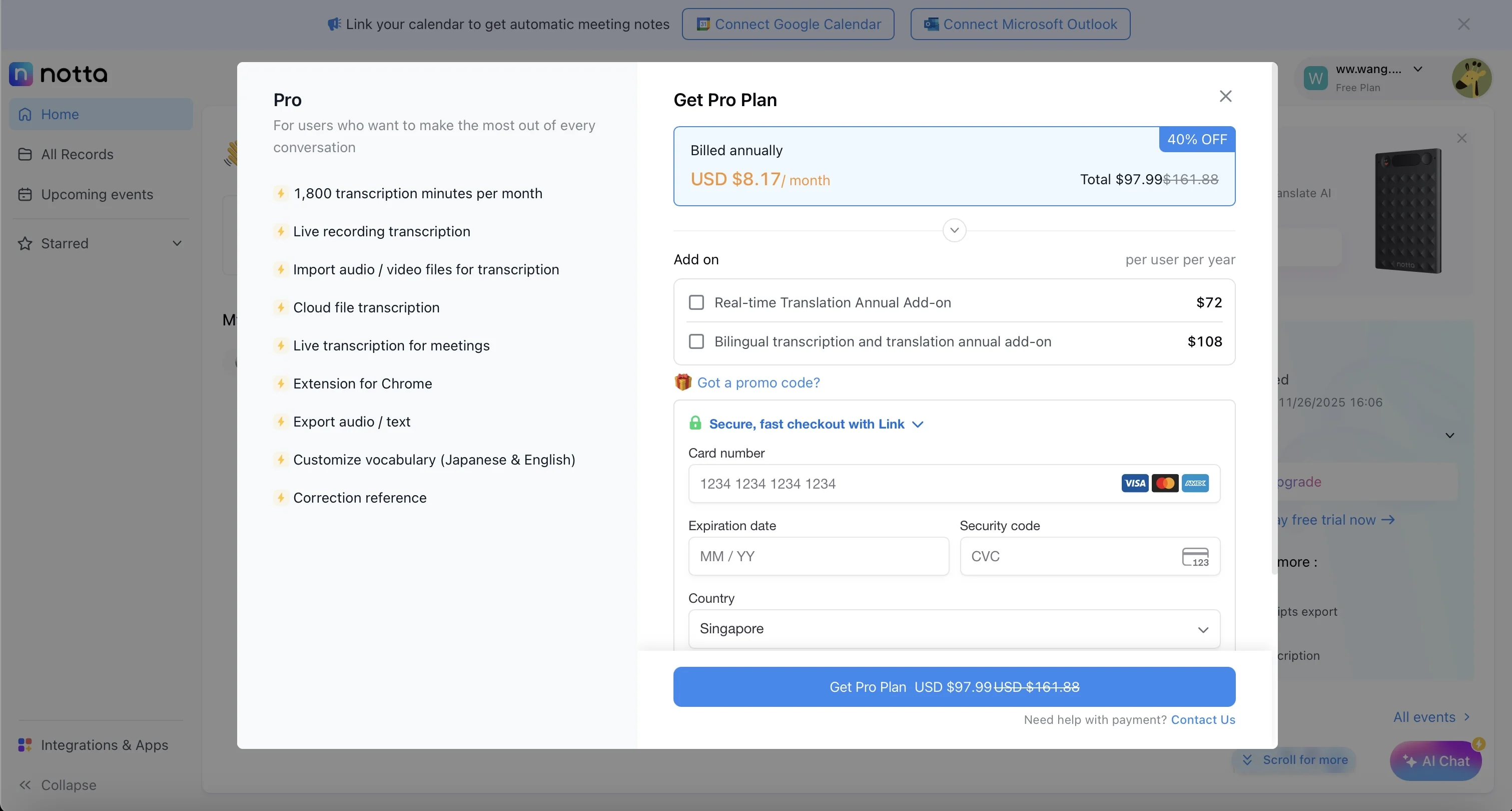Notta.ai Analysis: How a $675K MRR Revenue Machine Uses the Perfect Growth Flywheel
Deep dive into how Notta.ai converts nearly 5 million monthly visitors into an estimated $675K in monthly recurring revenue through textbook-level PLG strategies.
Summary
First, the numbers: We estimate that Notta.ai's Monthly Recurring Revenue (MRR) is approximately $675,000 USD, with an Annual Recurring Revenue (ARR) exceeding $8 million USD.
Core Product: Notta.ai is an AI-powered speech-to-text tool that transcribes meetings, interviews, and various audio/video content in real-time, designed to free users from tedious note-taking tasks.
Key Metrics: The product attracts nearly 5 million monthly visitors, with growth driven by a powerful SEO matrix covering over 100,000 keywords.
 Notta.ai Website Traffic Overview
Notta.ai Website Traffic Overview
The "Secret Sauce": Notta.ai's growth flywheel is not driven by a single technological moat, but rather by the perfect combination of a "traffic harvesting machine" and an "experience loop." Through a precise SEO matrix, it captures massive "problem-oriented" traffic, then seamlessly converts free users into paying subscribers with an excellent product experience and cost-effective pricing. Its success is a textbook example of PLG (Product-Led Growth) strategy.
Chapter 1: Product and Value Proposition
Notta.ai's core value proposition is crystal clear: "Focus on the conversation, not the notes." It precisely addresses the core pain point for professionals, students, journalists, and content creators—manually organizing audio/video information is time-consuming and inefficient.
The product's strength is evident in three dimensions:
- Solid core capabilities: Provides high-accuracy multilingual transcription services, which is its foundation.
- Seamless workflow integration: Notta.ai's true moat lies in its ability to deeply embed into users' existing workflows. Through integration with Google Calendar, Microsoft Outlook, Zoom, and Google Meet, it transforms transcription from an isolated "tool" into an automated "process." This significantly reduces user friction and barriers to adoption.
- Smart Freemium model: The free tier provides sufficient functionality for users to experience the core value (the "aha moment"), while naturally guiding frequent users to upgrade through limitations like transcription duration.
Chapter 2: Deep Analysis of the Growth Flywheel
Notta.ai's growth model can be broken down into three interconnected engines.
Engine 1: SEO "Traffic Harvesting Machine"
Notta.ai's primary growth driver comes from its strong organic search traffic. Instead of betting on brand keywords, it built a massive, problem-based keyword matrix.
 Notta.ai Organic Search Keywords in the US Market
Notta.ai Organic Search Keywords in the US Market
Evidence shows that in the US market alone, it covers over 104,000 organic keywords. Keywords like voice recorder, convert sound to text, and youtube video summarizer precisely capture users who are already aware of their problem and actively seeking solutions. This strategy has much higher ROI than relying on advertising.
Engine 1.1: Aggressive "Competitor Keyword Interception" Strategy
Beyond broad coverage of "user problem" keywords, Notta.ai also executes a more aggressive advanced SEO strategy: directly intercepting competitor traffic.
This is not speculation, but documented fact. Notta.ai has specifically created comparison pages, such as "YouTube MP3ダウンロード完全ガイド!おすすめツール15選と安全な使い方" (https://www.notta.ai/blog/youtube-mp3-download-tools-guide) and "Happy Scribe vs Otter.ai" (https://www.notta.ai/en/blog/happy-scribe-vs-otter-ai).
Engine 2: PLG "Conversion Engine"
When massive traffic pours in, the product itself takes over the conversion task.
- Instant value: Users can quickly obtain high-quality transcripts without complex setup—simply upload an audio file or connect a calendar, and the product value is instantly validated.
- Integration equals retention: When users link Notta.ai to their Google Calendar, the product transforms from a "use-and-go" tool into part of their workflow. Every meeting reminder becomes a reaffirmation of product value and a potential paid conversion opportunity.
- Contextual upsell: Upsell prompts appear at the most opportune moments. For example, when a free user's meeting is about to exceed the time limit, the system naturally prompts an upgrade for longer transcription duration.
Engine 3: Deep Workflow Integration as Evidenced by "Outbound Traffic"
This is perhaps the most counterintuitive yet brilliant part of Notta.ai's growth story. Analyzing its outbound traffic, we found not user churn, but ironclad evidence of product stickiness.
 Notta.ai Outbound Traffic Destinations
Notta.ai Outbound Traffic Destinations
Data shows that after leaving Notta.ai, users mainly go to google.com, microsoftonline.com, and zoom.us (source: outbound-destinations.webp). This is not a simple redirect, but users performing account authorization and calendar connection—core actions. Each such "outbound" visit represents a user deeply binding Notta.ai into their workflow. This is the critical step in PLG where users move from "trial" to "dependence," dramatically increasing switching costs and long-term retention.
What's even more noteworthy is that their outbound traffic includes competitor turboscribe.ai. This reveals a highly confident content strategy: by writing "Notta vs. [competitor]" comparison articles, they not only intercept high-intent search traffic but also dare to directly link to competitors, using transparency and confidence to win user trust.
Chapter 3: Business Model and Revenue Estimation
Since Notta.ai uses embedded payments, we cannot directly track its payment gateway outbound traffic. Therefore, we built an estimation model based on public traffic data and industry benchmarks.
3.1 MRR Estimation Model
Disclaimer: The following is a reasonable estimate based on public data and industry benchmarks, aimed at revealing the magnitude of the business model, not a precise audit.
Step 1: Estimate Monthly New Paying Users
- Anchor data: Notta.ai has a stable monthly visit volume of approximately 5 million.
- Conversion assumption 1 (Visitor → Registered): For a PLG product with a strong free tool, we set the visitor-to-free-user registration conversion rate at 3%, which is a conservative industry estimate (source: "Product-Led Growth Benchmarks" by OpenView).
Monthly new registered users = 5,000,000 × 3% = 150,000 users
- Conversion assumption 2 (Free → Paid): Free-to-paid conversion rate is the core of PLG. Considering its broad traffic sources, we use 2.5% as the conversion rate benchmark.
Monthly new paying users = 150,000 × 2.5% = 3,750 users
Step 2: Estimate Average Revenue Per User (ARPU)
- Anchor data: Notta.ai's Pro annual subscription is $8.17/month.
 Notta.ai Pricing Plans
Notta.ai Pricing Plans - ARPU estimate: Considering that monthly subscriptions are typically more expensive, higher-value team plans, and add-on purchases, we estimate a blended ARPU of $12/month. This accounts for different user segments' willingness to pay.
Step 3: Calculate Monthly New MRR
- Monthly new MRR = [Monthly new paying users] × [ARPU]
Monthly new MRR = 3,750 × $12 = $45,000
Step 4: Estimate Total MRR
- Core logic: Total MRR is the accumulation of historical paying users (minus churn). Stable new MRR usually means total MRR is a multiple of that.
- Growth multiple estimate: Traffic data shows Notta.ai has been operating and maintaining high traffic for over a year, proving it has accumulated a substantial paying user base. For a SaaS product with workflow stickiness, we use a 15x growth multiple to estimate the existing scale.
- Total MRR estimate = [Monthly new MRR] × [Growth multiple]
Total MRR = $45,000 × 15 = $675,000
Conclusion: Our model estimates that Notta.ai's Monthly Recurring Revenue (MRR) is approximately $675,000.
Chapter 4: The "Replication" Blueprint for Builders
Notta.ai's success provides valuable insights for AI application entrepreneurs.
4.1 Strategy 1: Migrate the "Upstream Traffic Arbitrage" Model Core: Don't just build a broad AI tool—build an "AI solutions matrix." For every specific question users enter into search engines (like "how to add subtitles to videos"), create a highly optimized independent tool page or blog post to capture traffic. Example: Instead of building a generic "AI writing tool," launch a series of tools like "Free AI Ad Copy Generator," "Free AI Weekly Report Generator," etc. Each small tool is an independent traffic entry point, all ultimately leading to your core paid product.
4.2 Strategy 2: "Value Deepening" in Vertical Domains Opportunity: Notta.ai is a general-purpose tool, but in specific industries, its value can be greatly deepened and amplified. Example: Develop a transcription tool specifically designed for lawyers, with models trained on legal terminology and court record formats, ensuring data compliance. Or a tool for healthcare that accurately recognizes medical terms and integrates into Electronic Medical Records (EMR) systems. Verticalization brings higher customer value and stronger pricing power.
4.3 Strategy 3: Rethink the Strategic Value of "Integration" Core: Notta.ai's success proves that the best products are invisible. As we saw from its outbound traffic data, users vote with their clicks—integration equals retention. Example: If you're building an AI design tool, don't just stop at exporting images. Build deep integrations with Figma, Canva, or even Webflow, allowing users to invoke your AI capabilities in their familiar environment with one click. Your product shouldn't be another tab to open—it should become a "super plugin" in users' existing toolkit.
This analysis is based on public data and industry research, intended for educational purposes only.
© 2025 WhoIsMakingMoney.ai - Making every AI project profitable
Want More Deep Analysis Like This?
Sign in to unlock all detailed analysis and weekly updated AI business case studies
Once signed in, you'll get access to all in-depth analysis including revenue data, business model breakdowns, growth strategies, and exclusive content.